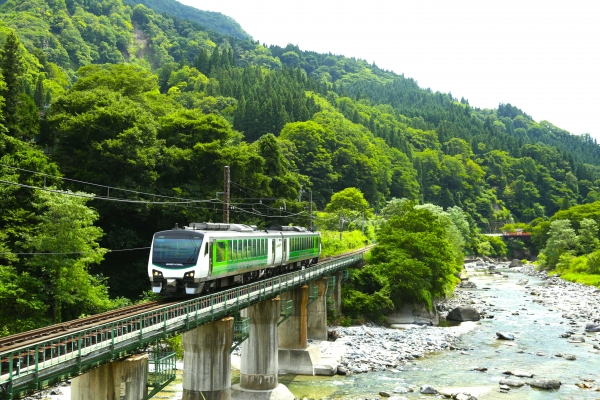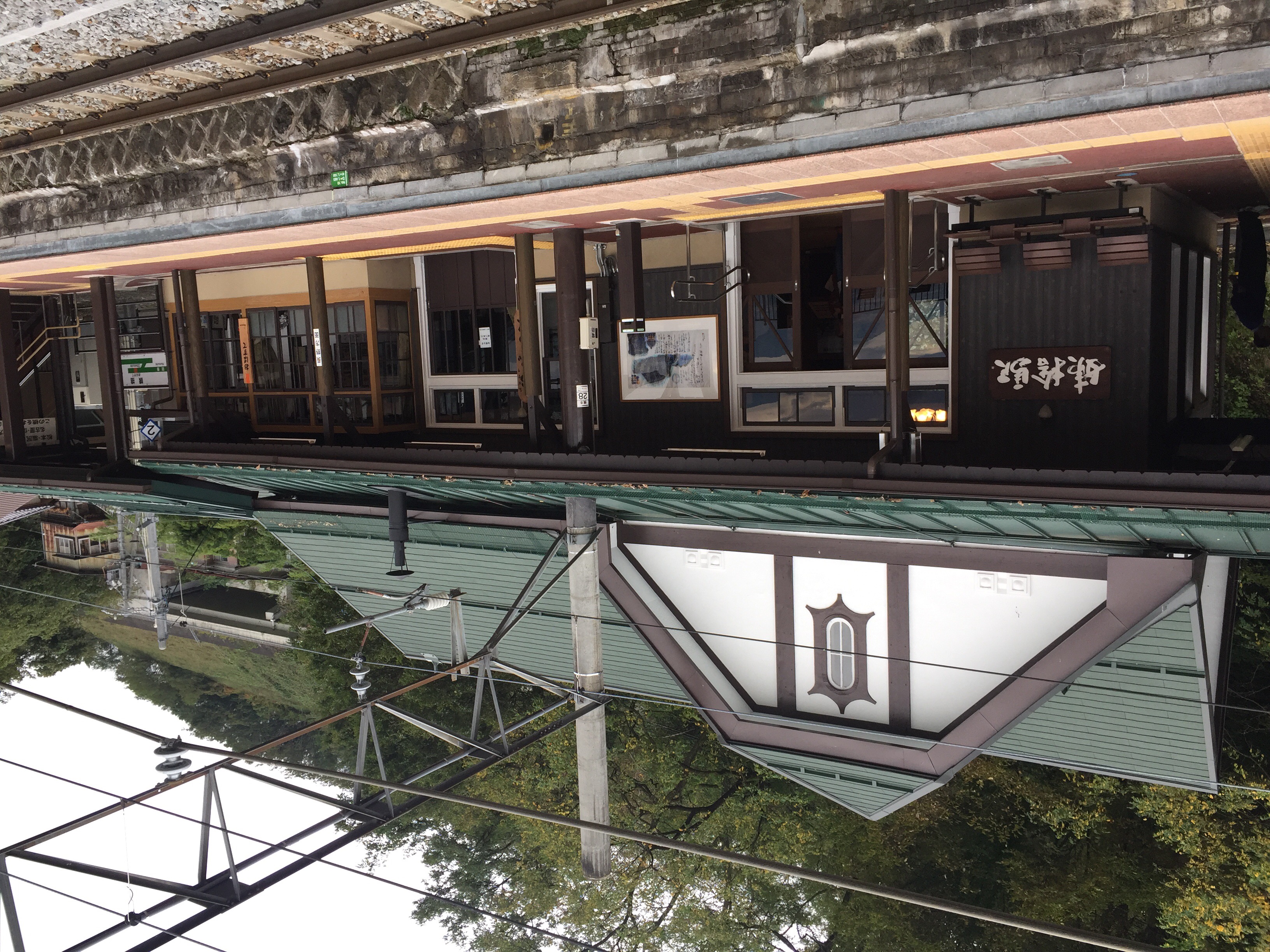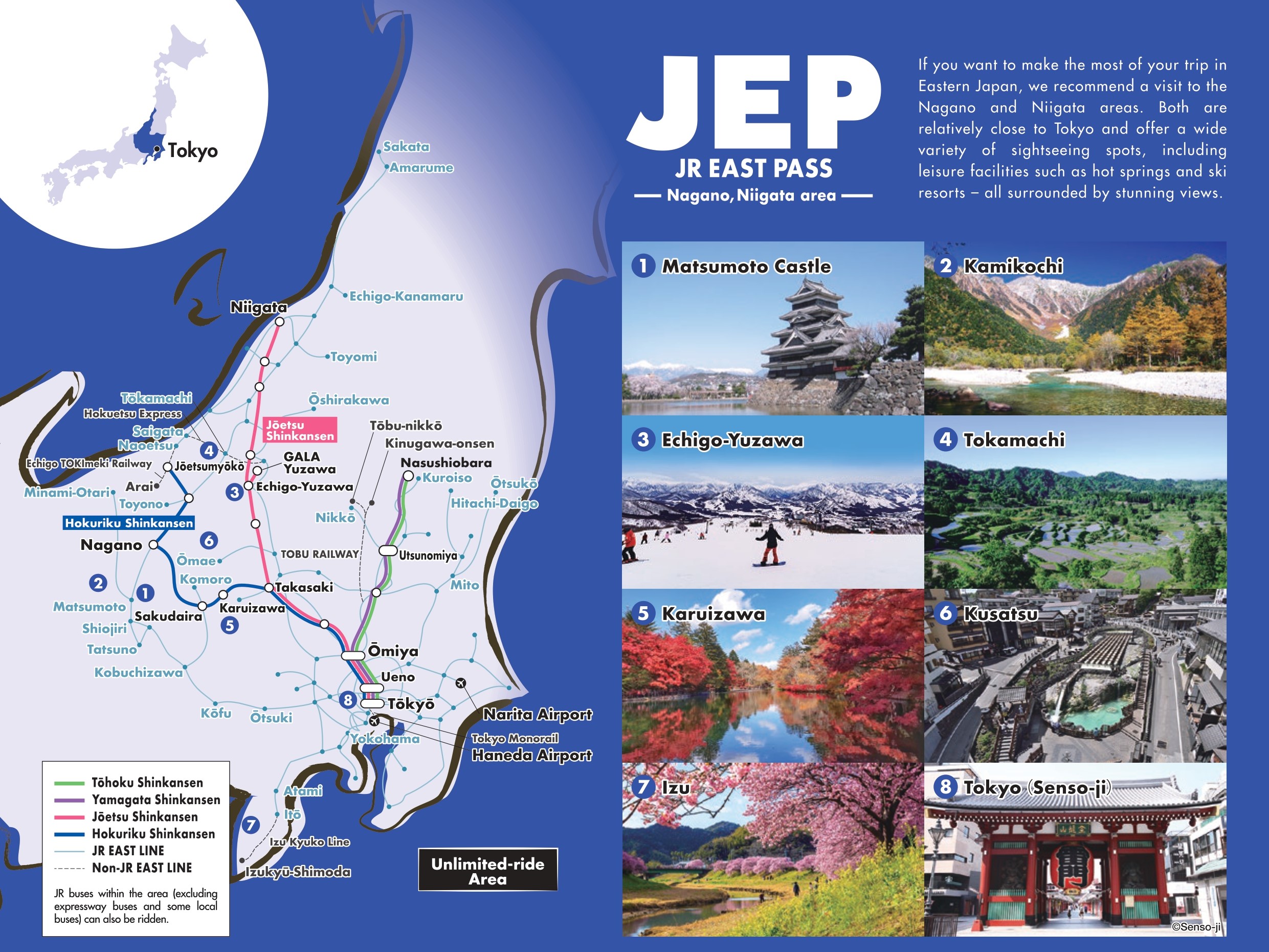Going back home: Resort View Furusato!

Previously I wrote about Oykot, a quaintly designed train that tours on the Iiyama Line from Nagano to Tokamachi along the serene and picturesque Chikuma River (千曲川 Chikuma-gawa). It is a train that I had the opportunity to ride back a few months ago during the winter in February, and it was a memorable experience. But the Oykot is not the only Joyful Train I got to hop on; there is another one showcasing a similarーalbeit altogether differentーvibe that I also got to experience. Let me introduce to you: the Resort View Furusato!
"Furusato" means hometown in Japanese, and therefore the Resort View Furusato is about invoking sense of nostalgia for their passengers. It is about going back to the countryside for rest and relaxation, about bringing back memories of the good old times away from the bustling urban cities and returning to one’s roots in rural birthplaces. In a way it is about going back in time; rather than looking forward to the future, it is about going back to the past and reliving your childhood away from current life’s modernity. For this article, I will showcase what the Resort View Furusato is all about!
Resort View Furusato. (Image credit: JR East Nagano Branch)
The Resort View Furusato began its operations in October 2010, and travels from JR Nagano Station (JR長野駅 Nagano-eki) all the way to JR Minami-Otari Station (JR南小谷駅 Minami-Otari-eki). What immediately stands out about it is the train itself: it uses a new hybrid train that is visually sleek and modern, and the same applies for the cabin as well. I took this train a day after Oykot and was immediately taken aback by the sheer difference in look and feel.

Arukuma, Nagano prefecture's mascot. (Image credit: JR East / Nazrul Buang)
Better yet, the train that I took was a special edition: it was covered with conspicuous designs depicting Arukuma, Nagano prefecture’s very own mascot! Arukuma is a green-coloured bear wearing a helmet shaped like an appleーthe fruit that Nagano is famous forーand it was designed about 10 years ago with the purpose of promoting the attractiveness of Shinshu region. A bit of trivia regarding the cuddly and lovable mascot: it even won the annual mascot design competition last year!

Resort View Furusato's exterior and interior. (Image credit: JR East / Nazrul Buang)
It gets better when I hopped on the Resort View Furusato. The train boasts a wooden floor finish topped with lush seats fitted with amazingly ample leg room (120 centimetres!). I could see that the train is designed with comfort in mind; it was easily one of the comfiest train rides I have ever experienced. Plus, the seats can even swivel: the train changes directions along the line, so when it does, passengers can simply switch the seat’s direction. You can choose to either sit facing forward or backward according to your liking!

Beverages menu onboard the Resort View Furusato. (Image credit: JR East / Nazrul Buang)
The concept of the Resort View Furusato involves allowing its passengers to get off at selected stations so that they can make sightseeing detours or have pleasant "slow life" experiences before coming back to the train. Life takes on a different pace in the Nagano countryside, and this train wants their passengers to take things slowly by immersing themselves in rural countryside.

JR Obasute Station on the Shinonoi Line. (Image credit: JR East / Kobori Akio)

Resort View Furusato arriving at JR Obasute Station. (Image credit: JR East / Kobori Akio)
The train stops at a small and unassuming station named Obasute (JR姨捨駅 Obasute-eki), and it is here where something amazing awaits. Passengers like myself get to witness a panoramic view of the Zenkoji Plains from the station platform, which is selected as one of Japan’s "Three Best Train Window Views". It is a breath-taking view indeed, and though the weather was not optimal, I felt thankful for being able to see something as wonderful as this. In fact, Obasute is famous for its rice terracesーalmost 2,000 in totalーand the passengers can see them by taking a 10-minute walk from the station. In fact, for the more ambitious travellers, they can opt for the Night View Obasute too: Resort View Furusato has a special night edition that departs from Nagano in this evening so that passengers can have a view from the station during sunset/nightfall.

View of Zenkoji Plains from JR Obasute Station. (Image credit: JR East / Nazrul Buang)

View from JR Obasute Station at night. (Image credit: JR East Nagano Branch)

Resort View Furusato passing by Obasute at dusk. (Image credit: JR East Nagano Branch)
Another highlight of Resort View Furusato awaits at JR Hotaka Station (JR穂高駅 Hotaka-eki). The train makes an extended stop here, and passengers can get off to take a short detour to the nearby Hotaka Shrine (trivia: the train station building itself is designed after the shrine). Upon arrival at JR Hotaka station, a shrine maiden (巫女 miko) will pick up the passengers and lead them to the nearby shrine (15 minutes away from the station). There, visitors can get a better sense of Azumino, the city that Hotaka is in, as well as the greater Japanese culture. They can lay their eyes on the amazing wooden sculptures of the shrines in the compound, and even buy some souvenirs such as amulets (お守り omamori).

JR Hotaka Station on the Ōito Line. (Image credit: JR East / Kobori)

Resort View Furusato arriving at JR Hotaka Station. (Image credit: JR East / Kobori)

Hotaka Shrine. (Image credit: JR East / Nazrul Buang)

Hotaka Shrine. (Image credit: JR East / Nazrul Buang)

Amulets (お守り omamori). (Image credit: JR East / Nazrul Buang)
Another surprise awaits at JR Shinano-Omachi Station (JR信濃大町駅 Shinano-Ōmachi-eki). Here, passengers can get off the train to have some local specialties such as oyaki (おやき), which are Japanese stuffed dumplings with various fillings such as pumpkin (かぼちゃ kabocha), red bean paste (餡こ anko), and a local type of mushroom called shimeji (占地). Even better, passengers can help themselves with a serving of sweet sake (甘酒 amazake), a beverage that is heavenly to enjoy especially during the cold winter! There is also a photo booth for those wanting to have a piece of memento to bring back from their brief stop at the station!

Complimentary oyaki and amazuke awaits at JR Shinano-Ōmachi Station. (Image credit: JR East / Nazrul Buang)
As the Resort View Furusato chugs along from JR Shinano-Omachi Station towards JR Hakuba Station (JR白馬駅 Hakuba-eki), passengers should keep their eyes peeled for the grand Nishina Three Lakes (仁科三湖 Nishina-sanko). This trio of lakes comprises of Lake Aoki (青木湖 Aoki-ko) the northernmost of the three; Lake Nakatsuna (中綱湖 Nakatsuna-ko), and Lake Kizaki (木崎湖 Kizaki-ko), the longest of the three. This majestic collection of lakes is a sight to behold, especially on a fair day when the water is clear.

Nishina Three Lakes ー Lake Kizaki. (Image credit: JR East / Nazrul Buang)

Lake Kizaki as seen along JR Inao Station. (Image credit: JR East / Kobori)
Another kind of trio awaits near Hakuba, which is widely known as one of Japan’s most popular ski resorts. Upon arriving at JR Hakuba station, passengers will get to witness a grand spectacle: the Hakuba Sanzan (白馬三山 Hakuba Three Mountains), a trio of majestic mountains that form a part of the Japanese Alps’s northern sector. On a clear day, passengers can see Mount Shirouma (the tallest of the three, standing at 2,932m), Mount Yari (second tallest at 2,903m), and Mount Shakushi (shortest one at 2,812m). Another fun fact: Hakuba and Shirouma are spelled with the same kanji characters: 白馬, which means white horse!

Hakuba "Sanzan" ー白馬三山, Hakuba Three Mountains. (Image credit: JR East / Kobori)

Hakuba "Sanzan" during autumn. (Image credit: JR East / Kobori)
It is fun to sometimes visit the Japanese countryside; sometimes you make discoveries you least expect and learn to appreciate the slower and quieter side of Japan. Eastern and central Japan has plenty of rural areas that I would implore people to visit. Better yet, they can do by taking Joyful Trains such as Resort View Furusato and explore the lesser known sides of Nagano prefecture. I got to experience two of them a few months ago and I truly hope that I can ride the others if the opportunity arises again.

Resort View Furusato in the winter. (Image credit: JR East Nagano Branch)
Resort View Furusato in the summer. (Image credit: JR East Nagano Branch)
A trip on the Resort View Furusato. (Video credit: JR East)
More details on Resort View Furusato
The Resort View Furusato travels between Nagano Station and Minami-Otari Station, and the departure times differ according to the calendar. Check out the timetable and schedule here. All seats on board this special train require reservations, which can be made online here. For more information on the train, you can visit the link here.
(INSIDER TIP: If you have the JR EAST PASS (Nagano, Niigata area), you can take the Resort View Furusato and make seat reservations for free!)
JR EAST PASS (Nagano, Niigata area)

The new JR EAST PASS (Nagano, Niigata area) and where you can use it. (Image credit: JR East)
The JR EAST PASS (Nagano, Niigata area) is an affordable pass that offers unlimited train rides on JR East lines, including bullet trains, within the valid area for 5 consecutive days. It's only ¥27,000, making it a considerable option for rail travellers. Pass holders can also reserve seats online for up to a month in advance for free on the JR-EAST Train Reservation.

The JR-EAST Train Reservation. (Image credit: JR East)
Header image credit: JR East




